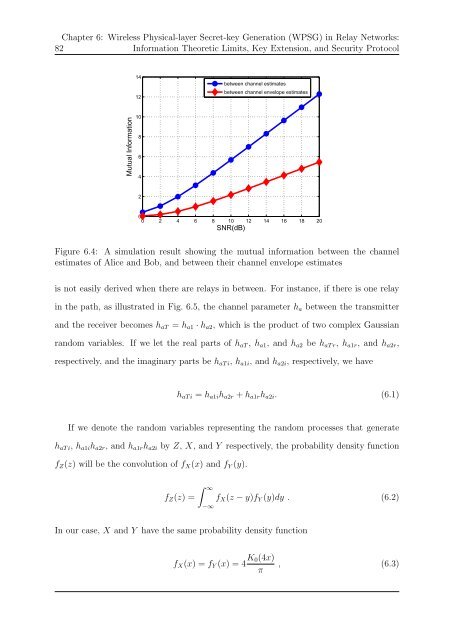Network Coding and Wireless Physical-layer ... - Jacobs University
Network Coding and Wireless Physical-layer ... - Jacobs University
Network Coding and Wireless Physical-layer ... - Jacobs University
Create successful ePaper yourself
Turn your PDF publications into a flip-book with our unique Google optimized e-Paper software.
Chapter 6: <strong>Wireless</strong> <strong>Physical</strong>-<strong>layer</strong> Secret-key Generation (WPSG) in Relay <strong>Network</strong>s:<br />
82<br />
Information Theoretic Limits, Key Extension, <strong>and</strong> Security Protocol<br />
14<br />
12<br />
between channel estimates<br />
between channel envelope estimates<br />
Mutual Information<br />
10<br />
8<br />
6<br />
4<br />
2<br />
0<br />
0 2 4 6 8 10 12 14 16 18 20<br />
SNR(dB)<br />
Figure 6.4: A simulation result showing the mutual information between the channel<br />
estimates of Alice <strong>and</strong> Bob, <strong>and</strong> between their channel envelope estimates<br />
is not easily derived when there are relays in between. For instance, if there is one relay<br />
in the path, as illustrated in Fig. 6.5, the channel parameter h a between the transmitter<br />
<strong>and</strong> the receiver becomes h aT = h a1 · h a2 , which is the product of two complex Gaussian<br />
r<strong>and</strong>om variables. If we let the real parts of h aT , h a1 , <strong>and</strong> h a2 be h aT r , h a1r , <strong>and</strong> h a2r ,<br />
respectively, <strong>and</strong> the imaginary parts be h aT i , h a1i , <strong>and</strong> h a2i , respectively, we have<br />
h aT i = h a1i h a2r + h a1r h a2i . (6.1)<br />
If we denote the r<strong>and</strong>om variables representing the r<strong>and</strong>om processes that generate<br />
h aT i , h a1i h a2r , <strong>and</strong> h a1r h a2i by Z, X, <strong>and</strong> Y respectively, the probability density function<br />
f Z (z) will be the convolution of f X (x) <strong>and</strong> f Y (y).<br />
f Z (z) =<br />
∫ ∞<br />
−∞<br />
f X (z − y)f Y (y)dy . (6.2)<br />
In our case, X <strong>and</strong> Y have the same probability density function<br />
f X (x) = f Y (x) = 4 K 0(4x)<br />
π<br />
, (6.3)

















